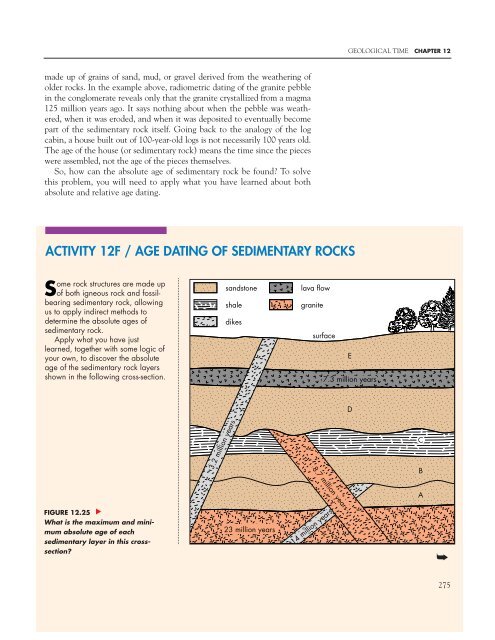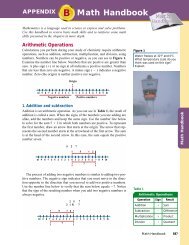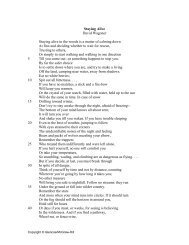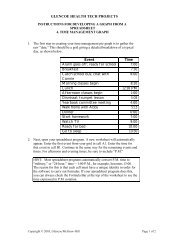Age Dating of Sedimentary Rock - Glencoe
Age Dating of Sedimentary Rock - Glencoe
Age Dating of Sedimentary Rock - Glencoe
Create successful ePaper yourself
Turn your PDF publications into a flip-book with our unique Google optimized e-Paper software.
GEOLOGICAL TIME CHAPTER 12<br />
made up <strong>of</strong> grains <strong>of</strong> sand, mud, or gravel derived from the weathering <strong>of</strong><br />
older rocks. In the example above, radiometric dating <strong>of</strong> the granite pebble<br />
in the conglomerate reveals only that the granite crystallized from a magma<br />
125 million years ago. It says nothing about when the pebble was weathered,<br />
when it was eroded, and when it was deposited to eventually become<br />
part <strong>of</strong> the sedimentary rock itself. Going back to the analogy <strong>of</strong> the log<br />
cabin, a house built out <strong>of</strong> 100-year-old logs is not necessarily 100 years old.<br />
The age <strong>of</strong> the house (or sedimentary rock) means the time since the pieces<br />
were assembled, not the age <strong>of</strong> the pieces themselves.<br />
So, how can the absolute age <strong>of</strong> sedimentary rock be found? To solve<br />
this problem, you will need to apply what you have learned about both<br />
absolute and relative age dating.<br />
ACTIVITY 12F / AGE DATING OF SEDIMENTARY ROCKS<br />
,, ,,<br />
Some rock structures are made up<br />
sandstone<br />
lava flow<br />
<strong>of</strong> both igneous rock and fossilbearing<br />
sedimentary rock, allowing<br />
shale<br />
us to apply indirect methods to<br />
,,granite<br />
,,<br />
determine the absolute ages <strong>of</strong><br />
dikes<br />
sedimentary rock. ,,,,,,,<br />
surface<br />
Apply what you have just<br />
learned, together with some logic<br />
,,,,,,,<br />
<strong>of</strong><br />
your own, to discover the absolute ,,,,,,,<br />
E<br />
age <strong>of</strong> the sedimentary rock layers<br />
shown in the following cross-section. 7.3 million years<br />
,,,,,,,<br />
,,, ,,,,,,,<br />
D<br />
,,,,,,,<br />
,,,<br />
,,,,,,,<br />
,,,<br />
C<br />
,,,,,,,<br />
B<br />
,,,,,,,<br />
A<br />
FIGURE 12.25<br />
What is the maximum and minimum<br />
absolute age <strong>of</strong> each<br />
23 million years<br />
,,,<br />
sedimentary layer in this crosssection?<br />
▲<br />
3.2 million years<br />
8.7 million years<br />
,,,,,<br />
14 million years<br />
➥<br />
275
Fossil Period Absolute age<br />
Clam<br />
Gastropod<br />
Oyster<br />
Ammonite<br />
Scallop<br />
Snail<br />
Leaf<br />
TABLE 12.2<br />
other<br />
sedimentary<br />
rock layers<br />
FIGURE 12.26 ▲<br />
Tertiary<br />
Triassic<br />
Cretaceous<br />
Jurassic<br />
Mississippian<br />
Silurian<br />
Recent<br />
Sample Data Table for Activity 12F<br />
igneous<br />
pebble<br />
conglomerate<br />
A<br />
B<br />
D<br />
C<br />
G<br />
E<br />
H<br />
I<br />
lava<br />
flow<br />
Radiometric age<br />
13.5 million years<br />
17.6 million years<br />
215 million years<br />
230 million years<br />
74 million years<br />
94 million years<br />
180 million years<br />
330 million years<br />
350 million years<br />
420 million years<br />
9500 years<br />
volcanic<br />
ash<br />
igneous<br />
dike<br />
Use the absolute age <strong>of</strong> the igneous rocks to determine the age <strong>of</strong> each fossil.<br />
F<br />
1. Figure 12.25 shows layers <strong>of</strong> sedimentary<br />
rock (labelled A, B, C, D, and E) as well as<br />
some igneous rocks. The igneous rocks<br />
include a lava flow which is cut by one <strong>of</strong><br />
three dikes, and a plutonic rock body. The<br />
absolute ages <strong>of</strong> these igneous rocks were<br />
determined through radiometric dating and<br />
are given on the diagram.<br />
Determine the range <strong>of</strong> the absolute age<br />
<strong>of</strong> each <strong>of</strong> the sedimentary layers. Construct<br />
your own table in which to record these<br />
ages.<br />
2. In a sentence or two, describe how you<br />
solved this problem.<br />
3. To prepare for the next step, copy Table<br />
12.2 into your notebook. (“Period” in the<br />
middle column refers to the segment <strong>of</strong> the<br />
Standard Geological Column in which each<br />
fossil was found.)<br />
4. The cross-sections shown in Figure 12.26<br />
are from five different localities. Each one<br />
shows igneous rocks and layers <strong>of</strong> fossilbearing<br />
sedimentary rock. The absolute age<br />
<strong>of</strong> the igneous rocks (found by radiometric<br />
dating) is also shown. Determine the<br />
absolute age range <strong>of</strong> each fossil at each<br />
site, and record these ages on the table.<br />
5. Once you know the absolute age <strong>of</strong> fossils,<br />
they can be used to find the absolute age <strong>of</strong><br />
sedimentary rocks associated with them.<br />
Study the three cross-sections in Figure<br />
12.27, and determine the absolute age <strong>of</strong><br />
each sedimentary rock layer shown. Record<br />
these ages on a sketch you make <strong>of</strong> the<br />
cross-sections.<br />
6. Describe in a sentence or two how you<br />
solved this problem.<br />
DISCUSSION<br />
1. What is the reason that radioactive isotopes<br />
cannot be used to directly measure the<br />
absolute age <strong>of</strong> a sedimentary rock?<br />
2. Name and describe as many kinds <strong>of</strong> rocks<br />
and structures as you can that might be<br />
dated using radiometric methods.<br />
3. Describe how fossils can be used to find<br />
(a) the relative age and<br />
(b) the absolute age <strong>of</strong> a sedimentary rock<br />
layer. ❖<br />
276
















